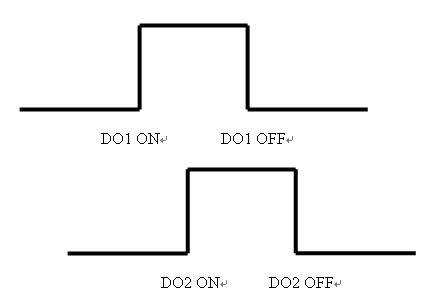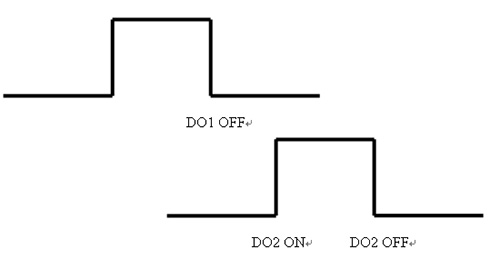The ASDA-A2 series offers the function of the Digital Outputs (DO). How do I modify this DO function as user-defined output timing?
For the timing, there are two conditions described as below:
Example 1: When the output timing of two digital outputs overlaps
In Figure 1, there is a period of time when DO1 and DO2 overlaps. DO1 and DO2 are both ON for a short overlapping time. Please refer to the following steps to modify the user-defined output timing.

Figure 1. When the output timing of the two digital outputs overlaps
Step 1:
First, use the parameter writing function of the PR mode to write four-level compare values, input 1 ~ input 4, and store the written compare values in the data array. Then, define the functions of these four inputs as follows:
Set the first compare value input 1 as the output timing used to enable DO1 to ON.
Set the second compare value input 2 as the output timing used to enable DO2 for ON.
Set the third compare value input 3 as the output timing used to set DO1 to OFF.
And set the fourth compare value input 4 as the output timing used to set DO2 to OFF.
Step 2:
When the motors start running, activate the 1st-level compare function. The compared value is the first input value of the data array. After the compare function is executed, call PR#45 by using the jump command to write parameter P4-06=0x0001 via software and enable DO1 for ON.
Step 3:
Next, change the jump command to call the PR path that is used to write the next value of parameter P4-06.
Step 4:
Repeat steps 2 to 3 to compare the first, second and third values, which means the compare values of input 1, input 2 and input3. After input 2 is compared, DO2 is set to ON. After input 3 is compared, DO1 is set to OFF. Then, after input 4 is compared, DO2 is set to OFF.
Example 2: When output timing of two digital outputs is independent
In Figure 2, DO2 is ON for a period of time after the DO1 is turned OFF. For modifying the user-defined output timing, only the last step is different. Please refer to the following steps:
1.Perform steps 1 to 3 mentioned above in Example 1.
2.Repeat steps 2 to 3 to compare the first, second and third values, which means the compare values of input 1, input 2 and input3. After input 2 is compared, DO1 is set to OFF. After input 3 is compared, the DO2 is set to ON. Then, after input 4 is compared, DO2 is set to OFF.

Figure 2. When the output timing of two digital outputs is independent